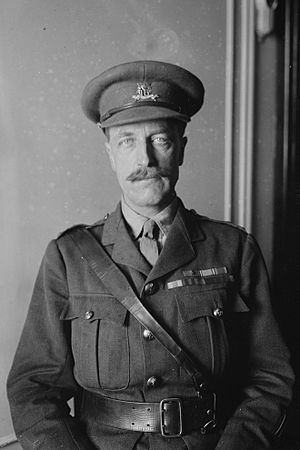Alexander Murray, 8th Earl of Dunmore facts for kids
Quick facts for kids
The Earl of Dunmore
|
|
|---|---|
 |
|
| Born | 22 April 1871 Portland Place, London |
| Died | 29 January 1962 (aged 90) Sussex Place, London |
| Buried |
Golders Green Crematorium
|
| Allegiance | United Kingdom |
| Service/ |
British Army |
| Years of service | 1892–1907 1914–1918 |
| Rank | Major |
| Unit | 16th Lancers (The Queen's) |
| Commands held | 31st Battalion, Imperial Yeomanry |
| Battles/wars | Mahdist War Tirah Campaign Malakand Frontier War Second Boer War World War I |
| Awards | Victoria Cross Distinguished Service Order Member of the Royal Victorian Order |
Alexander Edward Murray, 8th Earl of Dunmore VC DSO MVO DL (born April 22, 1871 – died January 29, 1962) was a brave British soldier and politician. Before he became the Earl of Dunmore in 1907, he was known by the special title Viscount Fincastle. He is most famous for earning the Victoria Cross, the highest award for bravery in the British military.
Contents
Early Life and Military Adventures
Alexander Murray was born in London on April 22, 1871. His parents were Charles Murray, the 7th Earl of Dunmore, and Lady Gertrude Coke. From a young age, he was known as Viscount Fincastle. He went to Eton College, a famous school, before joining the army.
In 1892, Alexander joined the 16th Lancers (The Queen's) and was sent to India. From 1895 to 1897, he worked as an aide-de-camp (a personal assistant) to the Viceroy of India, who was like the British ruler of India. In 1896, he traveled to Sudan and fought in the Mahdist War, a conflict in that region.
Winning the Victoria Cross
In 1897, when he was 26, Lieutenant Alexander Murray returned to India. He was also working as a war correspondent (a journalist reporting from a war zone) for The Times newspaper.
On August 17, 1897, during a battle at Nawa Kili in India, Lieutenant Murray showed incredible bravery. Along with two other officers and five soldiers, he went into heavy enemy fire. Their mission was to rescue a fellow officer, Lieutenant R. T. Greaves, who was badly wounded and surrounded by enemy fighters.
While they were trying to bring the wounded officer to safety, he was sadly killed by another bullet. One of the rescue officers was also badly wounded, and four horses were shot. Despite the danger, their actions were recognized as extremely courageous.
The message sent to their leaders described the event:
During the fighting at Nawa Bali, in Upper Swat, on the 17th August, 1897, Lieutenant-Colonel R. B. Adams proceeded with Lieutenants H. L. S. MacLean and Viscount Fincastle, and five men of the Guides, under a very heavy and close fire, to the rescue of Lieutenant R. T. Greaves, Lancashire Fusiliers, who was lying disabled by a bullet wound and surrounded by the enemy's swordsmen. In bringing him under cover he (Lieutenant Greaves) was struck by a bullet and killed — Lieutenant MacLean was mortally wounded — whilst the horses of Lieutenant-Colonel Adams and Lieutenant Viscount Fincastle were shot, as well as two troop horses.
For his bravery, Alexander Murray received the Victoria Cross. This is the highest award for courage in the British armed forces. He was also the only journalist at the time to receive this honor.
Later Career and World War I
After his time in India, Alexander Murray wrote a book about his experiences in 1898. In 1899, he went to South Africa to fight in the Second Boer War. He was part of the forces that helped relieve the Siege of Kimberley, a major event in the war.
In 1901, he formed a new group of soldiers called Fincastle's Horse. He was put in charge of this battalion with the rank of Lieutenant-colonel. For his service in South Africa, he was mentioned in official reports for his good work. This is called a Mentioned in Despatches.
In 1906, he received another award, the Royal Victorian Order. This was for helping the Prince of Wales with the wedding of King Alfonso of Spain. In 1907, his father passed away, and Alexander became the 8th Earl of Dunmore. He then left the army to manage his family's large estates.
When World War I began in 1914, he returned to active duty. He served as a staff officer on the Western Front, which was a major battle area. During the Battle of the Somme, he was awarded the Distinguished Service Order for his leadership. He was also mentioned in official reports four more times and was wounded twice during the war.
After the war, between the 1920s and 1930s, Alexander Murray became involved in politics. He served in the House of Lords, which is part of the British Parliament. He held roles like Captain of the Honourable Corps of Gentlemen-at-Arms and Lord-in-waiting, which involved helping the government and the royal family. He also held a ceremonial role as Deputy Lieutenant of Inverness-shire in Scotland.
Family Life
On January 5, 1904, Alexander Murray married Lucinda Dorothea Kemble. They had three children:
- Lady Marjorie Hilda Murray (1904-2000)
- Edward David Murray, Viscount Fincastle (1908–1940). Sadly, he was killed in action in France during World War II.
- Lady Mary Elizabeth Murray (1913-2000)
Alexander Murray passed away in London on January 29, 1962, at the age of 90. His titles then went to his grandson, John Alexander Murray, who became the 9th Earl of Dunmore.
Images for kids


